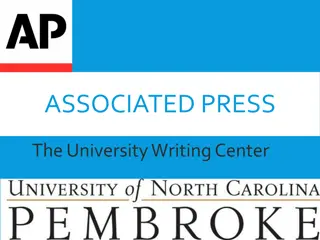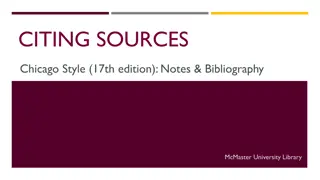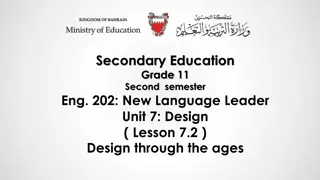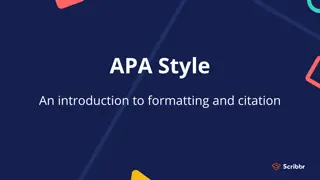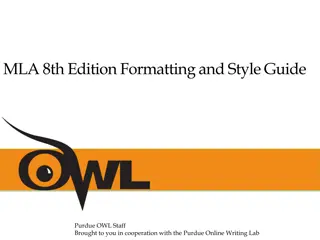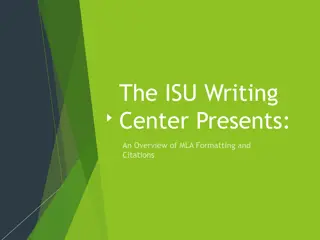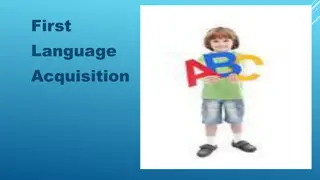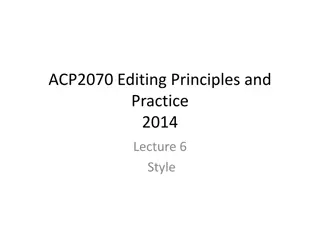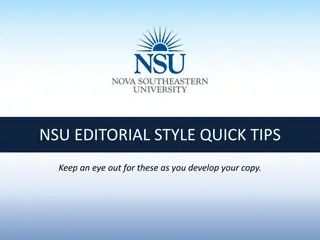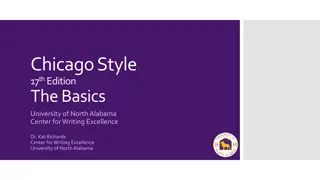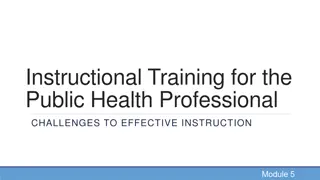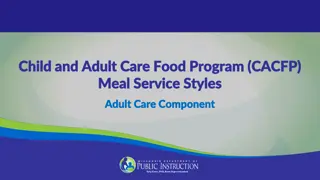Style N Scissors, Crafting Elegance in the Heart of Jaipur
Style N Scissors has rightfully earned its place as the best salon in Jaipur, offering a perfect blend of luxury, expertise, and personalized service. Indulge in the epitome of beauty and elegance at Style N Scissors, where your journey to glamour begins.
0 views • 3 slides
Language Study Community – Enhance Your Language Skills
Joining a Language Study Group is a fantastic way to take your language learning to the next level. By leveraging the power of Group Study, you can immerse yourself in the language, enhance your understanding, and build confidence in your speaking abilities. Read full article \/\/explainlearning.com
1 views • 3 slides
Improving Academic Writing: Key Aspects of Academic Style and Referencing
Learn about academic style in English, principles of referencing, and how to write effectively for assignments. Understand the functions of academic style, such as clear communication and showcasing membership in the academic community. Explore a paragraph analysis on making people work harder, iden
0 views • 29 slides
APA 7th Edition Citation Style Guidelines for Information Management Program
Learn the essentials of APA 7th edition citation style for information management programs, including in-text citations, reference lists, and formatting requirements. Understand how to cite sources, figures, tables, and visual material correctly to maintain citation style accuracy throughout academi
1 views • 21 slides
Academic Language Demands and Supports in Instructional Planning
Academic Language Demands and Supports are crucial in educational settings to ensure comprehension and usage of language by students. This content discusses embedding language demands in lesson plans, providing language supports, and peer review activities to enhance academic language skills. The fo
6 views • 10 slides
The Significance of Media in Language Learning
Media plays a crucial role in language learning by raising awareness of the ideology behind linguistic structures and providing valuable information on society and culture. Linguists are drawn to media language for research purposes and to understand its impact on language use and attitudes. Media s
12 views • 5 slides
Understanding Translation: Key Concepts and Definitions
Translation involves transferring written text from one language to another, while interpreting deals with oral communication. Etymologically, the term "translation" comes from Latin meaning "to carry over." It is a process of replacing an original text with another in a different language. Translat
11 views • 76 slides
Serve in Style Choosing the Right Tennis Dress
Tennis is not just a sport; it's a statement of style and grace on the court. As a tennis player in Dubai, you understand the importance of not only performing well but also looking good while doing it. That's why selecting the perfect tennis dress is essential for both comfort and confidence on the
6 views • 1 slides
Jamaican Style Curry Powder | Homechoicejamaica.com
The Jamaican-style curry powder available at Homechoicejamaica.com will transport you to the real flavors of Jamaica. Utilize our special blend to enhance your cuisine.\n\nWebsite:- \/\/homechoicejamaica.com\/product-category\/jamaican-style-indian-curry-powder\/
0 views • 1 slides
Springtime Splendor Elevating Your Style with Floral Sarees
#pulimoottilsilks #fashion \nWhether for special occasions or everyday wear, floral sarees epitomize versatility and style. As spring unfolds its splendor, embracing the enchanting allure of floral sarees promises a journey of sartorial delight and self-expression.\n\nRead the detailed blog here, \/
0 views • 6 slides
Stay Sun-Safe in Style Stylish Ways to Protect Yourself While Wearing Sarees in Summer
By opting for breathable fabrics, accessorizing wisely, layering up, practicing sun-safe skincare, choosing full-sleeve blouses, and embracing the umbrella, you can protect yourself from harmful UV rays without compromising on style. So go ahead, and flaunt your favorite sarees with confidence this
0 views • 6 slides
Jorde Calf Varsity Jackets_ The Perfect Blend of Comfort and Style
Jorde Calf varsity jackets represent the perfect blend of comfort and style, making them a valuable addition to any wardrobe. With their superior craftsmanship, customizable features, and versatile design, these leather jackets for Women offer a unique way to express personal style while enjoying th
1 views • 6 slides
Suit Case Style Rigid MDF Board Boxes
Here's a overview of what you might expect from a \"Suitcase Style Rigid MDF Board Box\" by Papers Gallery:\n1.\tDesign: Suitcase-style boxes typically feature a handle and may include clasps or latches for secure closure, mimicking the look of a traditional suitcase.\n2.\tAesthetics: These boxes ca
1 views • 2 slides
Unlock Your Learning Style Potential
Discover how to identify and utilize your unique learning style effectively with this workshop led by Kayla Taylor. Learn about the different learning styles, take a quiz to find yours, and understand how to integrate your style into your daily life. Knowing your learning style can enhance academic
0 views • 9 slides
Understanding Behavioural Styles: The Analyst (Technician)
Explore the concept of behavioural styles introduced by David Merrill and Roger Reid in the 1960s, focusing on the Analyst style. This style embodies traits such as organization, setting long-term goals, high standards, duty, analysis, directness, decision-making, task-oriented focus, risk-taking, a
0 views • 28 slides
Essential Guidelines for AP Style: Writing Tips and Techniques
Writing in AP style requires adherence to specific guidelines including consistency, clarity, accuracy, and brevity. This writing style follows the inverted pyramid format, focusing on conveying information in a concise and direct manner. The structure emphasizes getting straight to the point, with
4 views • 23 slides
Understanding the Importance of Citing Sources in Chicago Style
Citing sources in Chicago Style (17th edition) is crucial to credit authors, avoid plagiarism, and provide readers with access to your research sources. This guide covers why to cite, when to cite, citation styles, Chicago Style notes and bibliography, in-text and endnotes, and creating a bibliograp
0 views • 10 slides
Understanding External CSS and How to Implement It
Learn the different methods of inserting CSS into your HTML documents, including inline styles, internal style sheets, and external style sheets using the tag. Explore the benefits of using external style sheets to easily update the look of your entire website. Follow step-by-step instruction
1 views • 8 slides
Exploring the Fascinating Architectural Style of Googie
Discover the origins and characteristics of Googie architecture, a modern style rooted in post-WWII American futurism. Learn how this unique style draws inspiration from Space Age ideals and revolutionized everyday buildings in the mid-20th century.
0 views • 17 slides
Understanding APA Style: Formatting and Citation Guidelines
APA Style, as defined by the American Psychological Association, offers guidelines for formatting and citations, especially in the social sciences. The 7th edition, introduced in 2019, covers aspects such as general formatting, in-text citations, tables, and figures. This comprehensive style is wide
1 views • 29 slides
Enhancing Language Learning Across the Curriculum in B.Ed. 1st Year Course
Language Across the Curriculum (LAC) emphasizes that language learning should occur across all subjects, not just in language classrooms. It highlights the importance of incorporating language development into every learning activity, fostering multilingualism in schools. Language plays a crucial ro
2 views • 34 slides
MLA Style Formatting Guidelines
MLA Style, established by the Modern Language Association, is commonly used in humanities disciplines. The 8th edition introduces principles for citing sources and covers aspects like document formatting, in-text citations, works cited lists, and more. This presentation provides an overview of how t
0 views • 43 slides
Mastering MLA Style: A Comprehensive Guide
The presentation by the ISU Writing Center covers the essentials of MLA style, including what MLA is, how to format papers, create in-text citations and Works Cited pages. It explains the overview of MLA style, why it is used, and the general rules to follow. Detailed information on creating headers
4 views • 19 slides
Understanding First Language Acquisition Process
First language acquisition is the process through which humans develop the capacity to perceive, comprehend, and effectively use language to communicate. It primarily focuses on infants acquiring their native language. Basic requirements, caregiver speech features, and the acquisition schedule play
0 views • 19 slides
Beach Gathering - Painting Critique and Analysis
A painting critique and analysis of a scene showing people gathered around a beach or lake, showcasing an older style of clothing. The artwork features a contrast of light and dark colors, painted in a pointillist style with different color values to depict textures and realistic scenes. The interpr
0 views • 7 slides
The Impact of Rugby Style Punting in College Football
Exploring the effectiveness of rugby style punting in college football, focusing on its benefits such as simplicity, versatility, and unpredictability. The rise in marketability and media attention around this strategic shift is also highlighted, along with its growing usage in the 2021-22 season. T
0 views • 9 slides
Speech and Language Developmental Milestones: A Bilingual/Multilingual Perspective
Speech and language developmental milestones are crucial for children, regardless of their home language. These milestones encompass receptive language, expressive language, pragmatics, and articulation and phonology. Understanding how a child hears and talks from birth to one year is essential, as
1 views • 23 slides
AP Style Writing Examples & Images
Explore examples of AP style writing in the form of sentences and images, covering topics like political figures, sports events, and journalistic experiences. Each sentence presents variations in punctuation and style following AP guidelines, accompanied by corresponding high-quality images. Practic
2 views • 61 slides
Mastering Style Guides for Effective Writing
Dive into the essence of style guides and their importance in establishing consistency and clarity in written content. Explore the various elements covered in a style sheet, from punctuation preferences to language variations, to enhance your writing skills and ensure coherence in communication.
0 views • 21 slides
NSU Editorial Style Quick Tips and Guidelines
Learn valuable NSU editorial style quick tips on punctuation, capitalization, grammar, numbers, and more to enhance the clarity and professionalism of your writing. Get insights on when to use the serial/Oxford comma, em dashes, and proper capitalization rules. Understand the correct usage of facult
0 views • 7 slides
Understanding Functional Styles in Language
The notion of style is explored in language use, including variations in literary and non-literary contexts, register linguistic features, and style-shifting according to formality. Definitions and classifications of style emphasize the distinctive features characteristic of register, genre, or auth
0 views • 30 slides
Understanding Chicago Style: A Comprehensive Guide
Chicago Style, established in 1906, is a widely used citation style in academia, providing guidelines for various disciplines. This guide covers the basics of Chicago Style, including its importance, recommended subtypes, formatting requirements, and more.
0 views • 39 slides
Introduction to Language Technologies at Jožef Stefan International Postgraduate School
This module on Knowledge Technologies at Jožef Stefan International Postgraduate School explores various aspects of Language Technologies, including Computational Linguistics, Natural Language Processing, and Human Language Technologies. The course covers computer processing of natural language, ap
0 views • 27 slides
Exploring Sociolinguistics: Language Variation and Social Factors
Sociolinguistics delves into the study of language variation influenced by social factors, examining the relationship between language and its social context. It explores various aspects like standard pronunciation, language choice, speech acts, language components, language variety, and factors suc
0 views • 73 slides
Understanding Assembly Language Programming for Computing Layers
Assembly language is a low-level programming language that enables direct interaction with a computer's hardware components. This content explores the fundamentals of assembly language, the relationship between human-readable machine language and binary code, an assembly language program for multipl
0 views • 31 slides
Effective Instructional Training Strategies for Public Health Professionals
This instructional training module focuses on identifying challenges to effective instruction in public health settings and provides methods and tactics to overcome them. It covers topics such as recognizing physical challenges, arranging optimal learning environments, addressing participant/learner
0 views • 14 slides
Understanding Language Anxiety in Foreign Language Learning and Teaching
Explore the impact of language anxiety on students and teachers in foreign language learning and teaching contexts through insights from Dr. Christina Gkonou's research. Delve into the theoretical background, implications for language education, and real-life experiences shared at the Essex Language
0 views • 25 slides
Understanding the DISC Personality Profiles
The DISC model, developed by William Moulton Marston, categorizes individuals into four behavioral styles based on whether they are people-oriented or task-oriented, as well as reserved or active. The Dominant (D) style is assertive and decisive, Influential (I) style is charismatic and motivating,
0 views • 9 slides
Understanding Author's Style: Language, Diction, and Voice
Author's style encompasses various elements like syntax, diction, tone, and perspective. By analyzing how language is used, dialogue realism, sentence structure, tone, and word choice, one can determine the unique voice of the author. This guide explains how to identify and evaluate an author's styl
0 views • 17 slides
Meal Service Styles in Child and Adult Care Food Program (CACFP)
Explore various meal service styles in the Child and Adult Care Food Program (CACFP), including cafeteria style, pre-plated style, family-style dining, and offer versus serve. Learn about the differences and requirements of each service style to provide nutritious meals to participants effectively.
0 views • 14 slides















